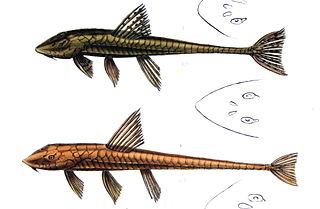
Loricariidae is the largest family of catfish, with 92 genera and just over 680 species. Loricariids originate from freshwater habitats of Costa Rica, Panama, and tropical and subtropical South America. These fish are noted for the bony plates covering their bodies and their suckermouths. Several genera are sold as "plecos", notably the suckermouth catfish, Hypostomus plecostomus, and are popular as aquarium fish.

Hypostomus is a genus of catfish in the family Loricariidae. They are native to tropical and subtropical South America. H. plecostomus is the popular freshwater aquarium fish formerly known as Plecostomus plecostomus. The taxonomic structure of the Loricariidae is still being expanded by scientists. Hypostomus is a highly species-rich and widely distributed catfish genus.

Otocinclus is a genus of catfish in the family Loricariidae native to South America, commonly known as "dwarf suckers" or "otos". This genus, like other loricariids, is characterized by rows of armour plating covering the body, as well as the underslung suckermouth. They are generally small in size; O. tapirape is the smallest of the species (2.4 cm), while O. flexilis is the biggest (5.5 cm). These species have adaptations that allow them to breathe air. A duct forms at the junction between the esophagus and the stomach and expands into an enlarged, ring-like diverticulum, characteristic of this genus, which allows air-breathing. Otocinclus are popular aquarium fish, and they are often purchased as algae eaters. It is difficult to breed them in captivity, and only wild caught Otocinclus are available to hobbyists. This genus is widely distributed east of the Andes of South America, throughout the lowlands from northern Venezuela to northern Argentina, but are generally absent from the Amazon and the Orinoco lowlands.
Listrura is a genus of pencil catfishes native to South America.
Cordylancistrus is a genus of suckermouth armored catfish native to South America. It is much the same as Chaetostoma. The few differences are a wider head, longer cheek odontodes, and plates on the snout. Cordylancistrus can be found in rivers and streams high in the Andes, from Venezuela to Colombia.

Peckoltia is a genus of small South American armored suckermouth catfishes. Many of these fish are popular aquarium fish.

Hemiancistrus is a genus of suckermouth armored catfishes. These species are native to South America. The taxonomy of this genus is complex and unclear, and major work has to be done. Many of these fish are popular aquarium fish.

Corymbophanes is a genus of armored catfish native to South America where they are only known from Guyana. Corymbophanes was originally placed in its own tribe Corymbophanini, but the first comprehensive molecular phylogenetic analysis of the subfamily Hypostominae found Corymbophanes to be nested within the tribe Ancistrini.
Nannoptopoma is a small genus of catfishes of the family Loricariidae. This genus includes two species, N. spectabile and N. sternoptychum.
Hisonotus is a genus of armored catfishes native to South America. Species of Hisonotus and Curculionichthys are the only representatives of the subfamily Otothyrinae having serrae on the posterior edge of the pectoral fin spine. These species are small fishes, generally found in small fast flowing streams, where they grasp to the branches and leaves of aquatic or subaquatic plants. The species of this genus mostly occur in Atlantic coastal streams of southern Brazil and the Paraguay-Paraná system of southern South America. They are also distributed in the Río de La Plata basin and coastal rivers of southeastern Brazil.

Loricariichthys is a genus of catfishes of the family Loricariidae.
Harttia is a genus of armored catfishes native to South America.
Neoplecostomus is a genus of fish in the family Loricariidae native to South America. Neoplecostomus can be distinguished from all other loricariids by a modified shield of small plates on the abdomen with posteriorly directed odontodes; the shield appears to act as a holdfast. The color pattern is generally mottled brown with the abdomen white. The head is long, rounded, and shovel-shaped. The fin spines are weak. They range from about 8 to 11 cm (3.1–4.3 in) SL. The species of Neoplecostomus live in fast-flowing water.
Glanapteryx is a genus of catfishes native to South America.
Pygidianops is a genus of pencil catfishes native to South America.
Typhlobelus is a genus of pencil catfishes native to South America.

Chaetostoma, also known as the bristlemouth catfish, is a genus of suckermouth armored catfishes native to South America with one species, C. fischeri, extending into Panama. Most species inhabit flowing rivers in the lower Andes and its foothills. Some species are kept in unheated aquaria.

Peckoltia sabaji is a species of catfish in the family Loricariidae. It is native to South America, where it occurs in the basins of the Rupununi, the Essequibo River, and the Takutu River in Guyana, as well as the basins of the Casiquiare canal, the Rio Negro, the Cinaruco River, and the Orinoco in Venezuela. It is usually found among boulders in medium to large rivers. The species reaches 19.8 cm SL and is of disputed classification.
Scott Allen Schaefer is an American ichthyologist working at the American Museum of Natural History as the dean of science for collections, exhibitions, and the public understanding of science; he serves as the curator-in-charge, in the department of ichthyology, within the division of vertebrate zoology.
'Pseudancistrus' megacephalus is a species of catfish in the family Loricariidae. It is of uncertain and disputed classification.








